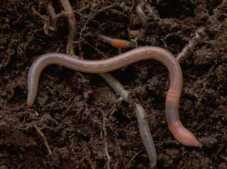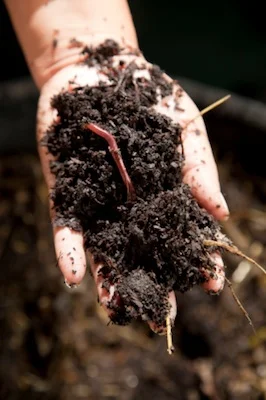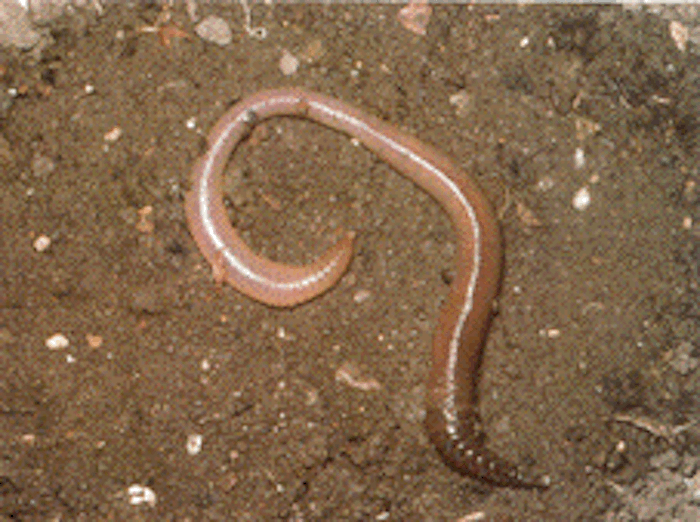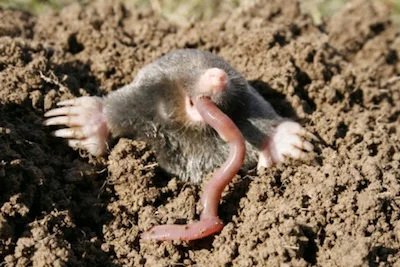Earthworms live everywhere in the world where there is soil.
Earthworms eat as they burrow through the soil.
Earthworms do not have teeth.
Earthworms help make the soil healthy.
Earthworms lay eggs.
There are about 2, 700 species (different kinds) of earthworms around the world.
Their habitat is soil.
Earthworms are good for the soil ©Getty Images
Earthworms are useful animals that recycle plant matter and turn it into good soil. They are also food for many birds and animals.
Earthworm bodies
Earthworms are invertebrates, which means they don't have backbones.
Their soft bodies can be brown, pink or even red. In the Philippines there are blue earthworms and one kind in the United Kingdom is green!
©Getty Images
Earthworm bodies have a mouth at one end and an anus at the other. The bodies are made up of many segments that look like rings, up to almost 200 of them. On each segment there are tiny hairs called setae (say see-tay), which help the worm move, along with the muscles that go around and along its body. The muscles squeeze and relax as the worm moves.
Earthworms have a brain, five hearts to pump blood, and parts inside their bodies which help them to breathe. The earthworm's body is covered with chemoreceptors (say kee-moe-ree-sep-tuz) which is how the worm tastes things. Chemoreceptors are tiny sense organs which detect chemicals in the soil.
A giant Gippsland earthworm
Getty Images
Earthworm sizes
The smallest earthworms are about 1 centimetre long and the largest can be 4 metres long. One of the largest earthworms is the giant Gippsland earthworm, found in just one part of Australia called Gippsland in the state of Victoria. They are classified as Vulnerable.
There are large earthworms in South Africa too.
Life Cycle
Earthworms are hermaphrodites (say her-maff-roe-dye-ts). This means that each earthworm has male parts that produce sperm and female parts that produce eggs. Worms have a band called a clitellum near the head end.
The clitellum is the pale band near the head. ©Getty Images
Earthworm clitellum, which contains eggs and sperm ©Getty images
When two earthworms mate, they lie together with heads pointing in opposite directions, and cover themselves in a sticky mucus. Each forms a cocoon on its clitellum, and these begin to get smaller, so the worms back out of them. As they do so, they both pass sperm and eggs into the cocoons. The sperm makes the eggs inside each cocoon grow. The tiny cocoon closes at both ends and becomes a hard ring that protects the eggs.
The eggs hatch after two weeks if the weather is warm, but they can take up to three months to hatch when it is cold. Usually up to five earthworms hatch out of each cocoon. The young worms are about 12 millimetres long and light pink in colour. Earthworms are able to mate when they are twelve months old.
How earthworms help soil and plants
Worms have recycled kitchen scraps into compost for the garden ©Getty Images
Earthworms dig large burrows which let water and air into the soil. This helps stop erosion and lets the water and air get down to the roots of plants. The burrows also help plant roots to move more easily through the soil and into new spaces.
Worms drag leaves and plant bits down into the earth. As they burrow, the worms swallow soil and eat the plant matter that is in it. The soil they swallow passes though the worm's body and is left in little piles on top of the ground. This is called castings and is excellent fertiliser (food for plants). People who farm worms sell composting worms and also worm castings to sell to gardeners. People can have worm farms in their own gardens.
Worms are food for birds and animals like this mole feasting on an earthworm ©Getty Images
It’s a good idea to get information from more than one source!
Watch a time lapse video showing how food scraps are converted into rich compost by earthworms
https://thekidshouldseethis.com/post/vermicomposting-time-lapse-for-kids
Find out about a worm's anatomy (body parts):
http://urbanext.illinois.edu/worms/anatomy/index.html









